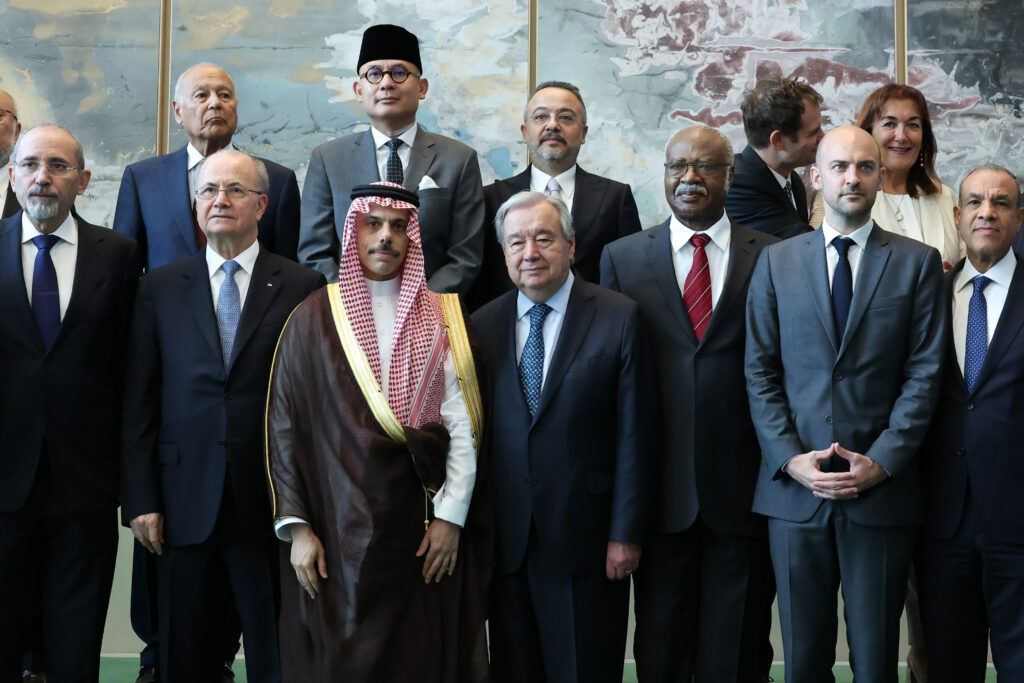Forceful pleas at UN for two-state solution for Israel, Palestinians
There is no alternative to a two-state solution between Israelis and the Palestinians, France told a UN conference co-chaired with Saudi Arabia Monday that was boycotted by Israel and branded a stunt by Washington.”Only a political, two-state solution will help respond to the legitimate aspirations of Israelis and Palestinians to live in peace and security. There is no alternative,” French Foreign Minister Jean-Noel Barrot said at the start of the three-day meeting.Days before the conference, French President Emmanuel Macron announced he would formally recognize Palestinian statehood in September, provoking strong opposition from Israel and the United States.Luxembourg hinted Monday that it could follow France and recognize a Palestinian state in September, with the possibility that other countries could announce similar plans when the conference resumes Tuesday.”All states have a responsibility to act now,” said Palestinian prime minister Mohammad Mustafa at the start of the meeting, calling for an international force to help underwrite Palestinian statehood.He called for the world to recognize Palestinian statehood, while later demanding that Hamas surrender control of the Gaza Strip and its arms as part of a deal to end fighting in the territory.France is hoping Britain will follow its lead. More than 200 British members of parliament on Friday voiced support for the idea, but Prime Minister Keir Starmer said that recognition of a Palestinian state “must be part of a wider plan.”United Nations Secretary-General Antonio Guterres said at the meeting “the two-state solution is farther than ever before.”According to an AFP database, at least 142 of the 193 UN member states now recognize the Palestinian state proclaimed by the Palestinian leadership in exile in 1988.In 1947, in a resolution approved by the General Assembly, the United Nations decided to partition Palestine, then under a British mandate, into Jewish and Arab states. Israel was proclaimed in 1948.For decades, most UN members have supported a two-state solution with Israel and a Palestinian state existing side-by-side.But after more than 21 months of war in Gaza, the ongoing expansion of Israeli settlements in the West Bank, and Israeli officials declaring designs to annex occupied territory, it is feared a Palestinian state could become geographically impossible.The current war in Gaza started following a deadly attack by Hamas on Israel, which responded with a large-scale military response that has claimed tens of thousands of Palestinian lives and destroyed most infrastructure in the enclave.Barrot said it would be an “illusion to think that you can get to a lasting ceasefire without having an outline of what’s going to happen in Gaza after the end of the war and having a political horizon.” – ‘Israeli unilateral actions’ -Beyond facilitating conditions for recognizing Palestine, the meeting will focus on three other issues: reform of the Palestinian Authority, disarmament of Hamas and its exclusion from Palestinian public life, and normalization of relations with Israel by Arab states.However, no new normalization deals are expected to be announced at the meeting, according to a French diplomatic source.Saudi Arabia’s Foreign Minister Faisal bin Farhan Al-Saud said US President Donald Trump could be a “catalyst” to ending the war in Gaza and jump-starting the two-state solution, stressing Riyadh had no plans to normalize relations with Israel.Following his plea to Trump, the US State Department labeled the three-day event “unproductive and ill-timed,” as well as a “publicity stunt” that would make finding peace harder.Jordan’s Foreign Minister Ayman Safadi said action was needed to counter Israeli “settlements, land confiscation (and) encroachments on the holy sites.”Israel and the United States were not taking part in the meeting, amid growing international pressure on Israel to end nearly two years of war in Gaza.Despite “tactical pauses” announced by Israel, the humanitarian catastrophe in Gaza will dominate speeches.Israeli Ambassador to the UN Danny Danon said “this conference does not promote a solution.”
DR Congo church massacre survivors recount night of terrorMon, 28 Jul 2025 21:35:04 GMT
Gunshots thundered and attackers burst into the church hall, picked out victims, tied them up and shot them dead, survivors of the massacre in northeastern Democratic Republic of Congo said Monday.Witnesses of the attack overnight Saturday to Sunday in Komanda, Ituri province, described to AFP how Allied Democratic Forces (ADF) fighters massacred dozens of worshippers …
DR Congo church massacre survivors recount night of terrorMon, 28 Jul 2025 21:35:04 GMT Read More »
Dollar rises on EU-US trade deal but European stocks turn sour
The dollar jumped Monday on the back of a US-EU trade deal, but the main European stock markets fell, reflecting unease at terms viewed as lopsided.Frankfurt closed sharply down, as shares in German carmakers plunged. Paris dipped, while London — outside the EU — also receded.Wall Street, meanwhile, finished mixed after a choppy session. Both the Nasdaq and S&P 500 edged to fresh records, while the Dow slipped.The US market’s “muted” reaction made sense given the heavy number of economic news releases this week that could move the market, said Angelo Kourkafas, senior global strategist at Edward Jones.”Because markets have run a lot in a short amount of time, we may get some good enough news, but they may not elicit the same reaction as some of the good news over the last couple of weeks when valuations were lower than they are today,” Kourkafas said. While Brussels defended the deal announced over the weekend as “better than a trade war with the United States,” several EU countries expressed unhappiness.European capitals saw the agreement’s 15 percent tariffs on most EU exports to the United States — but none on US exports to the EU — as skewed.As part of the deal, President Donald Trump said the bloc had agreed to purchase “$750 billion worth of energy” from the United States, and make $600 billion in additional investments.”While the deal has avoided a much worse outcome for now, it remains to be seen whether it will last,” cautioned Jack Allen-Reynolds, a eurozone economist at Capital Economics.With average US tariffs on EU imports now around 17 percent, “we think this will reduce EU GDP by about 0.2 percent,” he said.He predicted that “uncertainty is likely to remain high” because Trump “could still change his mind even after the deal has been finalized and signed.”Oil prices rose strongly.That was partly on relief from the deal — but also because Trump shortened a deadline for Russia to end its war in Ukraine to August 7 or 9, after which he vowed to sanction countries buying its crude.Monday also saw the start of a fresh round of trade negotiations between China and the United States ahead of August 12, when a 90-day truce between the economic superpowers is scheduled to end.Shares in European companies tracked the unease at the EU-US deal.Volkswagen, BMW and Porsche all shed more than three percent as the implications of high tariffs on their exports to the United States sank in. In Paris, shares in Pernod Ricard, which exports wine and spirits to the United States, fell more than three percent.Traders were prepared for a busy week in the United States, with a slew of corporate earnings reports — including from Apple, Microsoft, Meta and Amazon — and macro data readings coming their way giving indications about US jobs and growth.The Federal Reserve is expected to keep interest rates unchanged at its meeting this week, with investors focused on its outlook for the rest of the year given Trump’s tariffs and recent trade deals.- Key figures at around 2030 GMT -New York – Dow: DOWN 0.1 percent at 44,837.56 (close)New York – S&P 500: UP less than 0.1 percent at 6,389.77 (close)New York – Nasdaq Composite: UP 0.3 percent at 21,178.58 (close)London – FTSE 100: DOWN 0.4 percent at 9,081.44 (close)Paris – CAC 40: DOWN 0.4 percent at 7,800.88 (close)Frankfurt – DAX: DOWN 1.0 percent at 23,970.36 (close)Tokyo – Nikkei 225: DOWN 1.1 percent at 40,998.27 (close)Hong Kong – Hang Seng Index: UP 0.7 percent at 25,562.13 (close)Shanghai – Composite: UP 0.1 percent at 3,597.94 (close)Euro/dollar: DOWN at $1.1597 from $1.1742 on FridayPound/dollar: DOWN at $1.3356 from $1.3438Dollar/yen: UP at 148.52 yen from 147.69 yenEuro/pound: DOWN at 86.80 pence from 87.39 penceBrent North Sea Crude: UP 2.3 percent at $70.04 per barrelWest Texas Intermediate: UP 2.4 percent at $66.71 per barrel
Dollar rises on EU-US trade deal but European stocks turn sour
The dollar jumped Monday on the back of a US-EU trade deal, but the main European stock markets fell, reflecting unease at terms viewed as lopsided.Frankfurt closed sharply down, as shares in German carmakers plunged. Paris dipped, while London — outside the EU — also receded.Wall Street, meanwhile, finished mixed after a choppy session. Both the Nasdaq and S&P 500 edged to fresh records, while the Dow slipped.The US market’s “muted” reaction made sense given the heavy number of economic news releases this week that could move the market, said Angelo Kourkafas, senior global strategist at Edward Jones.”Because markets have run a lot in a short amount of time, we may get some good enough news, but they may not elicit the same reaction as some of the good news over the last couple of weeks when valuations were lower than they are today,” Kourkafas said. While Brussels defended the deal announced over the weekend as “better than a trade war with the United States,” several EU countries expressed unhappiness.European capitals saw the agreement’s 15 percent tariffs on most EU exports to the United States — but none on US exports to the EU — as skewed.As part of the deal, President Donald Trump said the bloc had agreed to purchase “$750 billion worth of energy” from the United States, and make $600 billion in additional investments.”While the deal has avoided a much worse outcome for now, it remains to be seen whether it will last,” cautioned Jack Allen-Reynolds, a eurozone economist at Capital Economics.With average US tariffs on EU imports now around 17 percent, “we think this will reduce EU GDP by about 0.2 percent,” he said.He predicted that “uncertainty is likely to remain high” because Trump “could still change his mind even after the deal has been finalized and signed.”Oil prices rose strongly.That was partly on relief from the deal — but also because Trump shortened a deadline for Russia to end its war in Ukraine to August 7 or 9, after which he vowed to sanction countries buying its crude.Monday also saw the start of a fresh round of trade negotiations between China and the United States ahead of August 12, when a 90-day truce between the economic superpowers is scheduled to end.Shares in European companies tracked the unease at the EU-US deal.Volkswagen, BMW and Porsche all shed more than three percent as the implications of high tariffs on their exports to the United States sank in. In Paris, shares in Pernod Ricard, which exports wine and spirits to the United States, fell more than three percent.Traders were prepared for a busy week in the United States, with a slew of corporate earnings reports — including from Apple, Microsoft, Meta and Amazon — and macro data readings coming their way giving indications about US jobs and growth.The Federal Reserve is expected to keep interest rates unchanged at its meeting this week, with investors focused on its outlook for the rest of the year given Trump’s tariffs and recent trade deals.- Key figures at around 2030 GMT -New York – Dow: DOWN 0.1 percent at 44,837.56 (close)New York – S&P 500: UP less than 0.1 percent at 6,389.77 (close)New York – Nasdaq Composite: UP 0.3 percent at 21,178.58 (close)London – FTSE 100: DOWN 0.4 percent at 9,081.44 (close)Paris – CAC 40: DOWN 0.4 percent at 7,800.88 (close)Frankfurt – DAX: DOWN 1.0 percent at 23,970.36 (close)Tokyo – Nikkei 225: DOWN 1.1 percent at 40,998.27 (close)Hong Kong – Hang Seng Index: UP 0.7 percent at 25,562.13 (close)Shanghai – Composite: UP 0.1 percent at 3,597.94 (close)Euro/dollar: DOWN at $1.1597 from $1.1742 on FridayPound/dollar: DOWN at $1.3356 from $1.3438Dollar/yen: UP at 148.52 yen from 147.69 yenEuro/pound: DOWN at 86.80 pence from 87.39 penceBrent North Sea Crude: UP 2.3 percent at $70.04 per barrelWest Texas Intermediate: UP 2.4 percent at $66.71 per barrel
Bouches-du-Rhône: pour lutter contre les incendies, des pompiers prépositionnés au plus près des massifs
Des “casernes temporaires”, pour attaquer les incendies au plus tôt: 550 pompiers étaient prépositionnés lundi à différents points stratégiques des Bouches-du-Rhône, département classé en risque d’incendie “très sévère” ces trois derniers jours, en application d’un dispositif préventif destiné à réduire les temps d’intervention.”L’objectif est d’intervenir rapidement sur des feux naissants, ou toute alerte, pour permettre la réduction du risque incendie”, précise auprès de l’AFP le capitaine Sacha Cabras, chef de colonne du groupement Ouest (secteurs de Vitrolles et Martigues notamment) des pompiers des Bouches-du-Rhône.Pour ce faire, il faut établir “un maillage territorial stratégique, pour avoir un délai d’intervention le plus court possible”, notamment en positionnant “des engins à des endroits faciles d’accès”, proches des axes routiers, ajoute-t-il.Cette “stratégie d’attaque des feux naissants est quasiment unique en Europe” et d’autres pays viennent régulièrement s’en inspirer auprès des sapeurs-pompiers français, relève Thomas Sabatier, chef d’un groupe d’intervention feux de forêt prépositionné à proximité du Stadium de Vitrolles ce lundi.Composé de 18 pompiers, professionnels et volontaires, quatre camions-citernes et un véhicule de commandement, l’unité est stratégiquement placée “à équidistance de Vitrolles et d’Aix-en-Provence, avec un accès direct au massif et à plein d’axes de communication”, détaille le lieutenant Sabatier.Au total, une trentaine de ces groupes, certains spécialisés dans l’attaque des feux, d’autres dans la protection des habitations, ont été déployés lundi à travers le département. Autant de “casernes temporaires” renforçant les existantes, ajoute Thomas Sabatier.Car ce dispositif préventif vient s’ajouter aux 500 pompiers présents dans la soixantaine de casernes du département, “le plus exposé au risque de feux de forêt en France métropolitaine”, rappelle régulièrement Météo-France.- Saison “particulièrement à risque” -L’institut météorologique a placé les Bouches-du-Rhône en vigilance rouge aux feux de forêt lundi, et ce pour la troisième journée consécutive, en raison de risques “très élevés” d’incendies à cause notamment d’un mistral soutenu. En outre, la préfecture a interdit l’accès à l’ensemble des 25 massifs du département.Une menace qui ne devrait pas faiblir dans les prochains jours: ainsi le département sera encore en vigilance orange mardi, le risque demeurant “élevé”.”Plusieurs indicateurs vont nous donner un niveau de risque pour une journée: l’hygrométrie, le vent, la température extérieure”, explique le capitaine Cabras, rappelant que “la plupart des feux sont des accidents”. “En fonction du risque, on met le nombre de moyens le plus adapté”.Par exemple, “aujourd’hui, au vu du vent monté assez rapidement et prévisible depuis quelques jours, on a mis les groupes en place à partir de 11H00”, deux heures plus tôt que sur une journée plus classique, poursuit le capitaine.Depuis le début de l’été 2025, les départs de feux se sont comptés “en centaines” dans les Bouches-du-Rhône, à raison de quinze à vingt par jour, ce qui en fait une saison “particulièrement à risque” après deux à trois années aux “étés assez modérés”, précise-t-il.Le 8 juillet, un incendie parti de la commune des Pennes-Mirabeau avant d’atteindre le nord de Marseille avait parcouru 750 hectares, ravageant une soixantaine de bâtiments au total. A ce moment-là, “on était à 40 interventions à gérer sur la même journée”, rappelle Sacha Cabras.Dix jours plus tard, un feu a dévoré près de 250 hectares de pinède à Martigues, au nord-ouest de Marseille.Illustrations, ce lundi après-midi, trois autres incendie ont mobilisé des dizaines de soldats du feu dans l’ouest du département: 115 soutenus par 21 engins à Martigues, 118 appuyés de 19 engins à Port-de-Bouc et 400 avec huit avions et hélicoptères bombardiers d’eau pour un sinistre qui a coupé les autoroutes A7 et A51 au niveau des Pennes-Mirabeau.”Depuis les dix dernières années, c’est l’une des saisons les plus précoces et les plus intenses en termes d’engagement des sapeurs-pompiers”, relève le capitaine Cabras. Même si les feux de forêt, “c’est toute l’année” concède-t-il aussitôt.
Bouches-du-Rhône: pour lutter contre les incendies, des pompiers prépositionnés au plus près des massifs
Des “casernes temporaires”, pour attaquer les incendies au plus tôt: 550 pompiers étaient prépositionnés lundi à différents points stratégiques des Bouches-du-Rhône, département classé en risque d’incendie “très sévère” ces trois derniers jours, en application d’un dispositif préventif destiné à réduire les temps d’intervention.”L’objectif est d’intervenir rapidement sur des feux naissants, ou toute alerte, pour permettre la réduction du risque incendie”, précise auprès de l’AFP le capitaine Sacha Cabras, chef de colonne du groupement Ouest (secteurs de Vitrolles et Martigues notamment) des pompiers des Bouches-du-Rhône.Pour ce faire, il faut établir “un maillage territorial stratégique, pour avoir un délai d’intervention le plus court possible”, notamment en positionnant “des engins à des endroits faciles d’accès”, proches des axes routiers, ajoute-t-il.Cette “stratégie d’attaque des feux naissants est quasiment unique en Europe” et d’autres pays viennent régulièrement s’en inspirer auprès des sapeurs-pompiers français, relève Thomas Sabatier, chef d’un groupe d’intervention feux de forêt prépositionné à proximité du Stadium de Vitrolles ce lundi.Composé de 18 pompiers, professionnels et volontaires, quatre camions-citernes et un véhicule de commandement, l’unité est stratégiquement placée “à équidistance de Vitrolles et d’Aix-en-Provence, avec un accès direct au massif et à plein d’axes de communication”, détaille le lieutenant Sabatier.Au total, une trentaine de ces groupes, certains spécialisés dans l’attaque des feux, d’autres dans la protection des habitations, ont été déployés lundi à travers le département. Autant de “casernes temporaires” renforçant les existantes, ajoute Thomas Sabatier.Car ce dispositif préventif vient s’ajouter aux 500 pompiers présents dans la soixantaine de casernes du département, “le plus exposé au risque de feux de forêt en France métropolitaine”, rappelle régulièrement Météo-France.- Saison “particulièrement à risque” -L’institut météorologique a placé les Bouches-du-Rhône en vigilance rouge aux feux de forêt lundi, et ce pour la troisième journée consécutive, en raison de risques “très élevés” d’incendies à cause notamment d’un mistral soutenu. En outre, la préfecture a interdit l’accès à l’ensemble des 25 massifs du département.Une menace qui ne devrait pas faiblir dans les prochains jours: ainsi le département sera encore en vigilance orange mardi, le risque demeurant “élevé”.”Plusieurs indicateurs vont nous donner un niveau de risque pour une journée: l’hygrométrie, le vent, la température extérieure”, explique le capitaine Cabras, rappelant que “la plupart des feux sont des accidents”. “En fonction du risque, on met le nombre de moyens le plus adapté”.Par exemple, “aujourd’hui, au vu du vent monté assez rapidement et prévisible depuis quelques jours, on a mis les groupes en place à partir de 11H00”, deux heures plus tôt que sur une journée plus classique, poursuit le capitaine.Depuis le début de l’été 2025, les départs de feux se sont comptés “en centaines” dans les Bouches-du-Rhône, à raison de quinze à vingt par jour, ce qui en fait une saison “particulièrement à risque” après deux à trois années aux “étés assez modérés”, précise-t-il.Le 8 juillet, un incendie parti de la commune des Pennes-Mirabeau avant d’atteindre le nord de Marseille avait parcouru 750 hectares, ravageant une soixantaine de bâtiments au total. A ce moment-là, “on était à 40 interventions à gérer sur la même journée”, rappelle Sacha Cabras.Dix jours plus tard, un feu a dévoré près de 250 hectares de pinède à Martigues, au nord-ouest de Marseille.Illustrations, ce lundi après-midi, trois autres incendie ont mobilisé des dizaines de soldats du feu dans l’ouest du département: 115 soutenus par 21 engins à Martigues, 118 appuyés de 19 engins à Port-de-Bouc et 400 avec huit avions et hélicoptères bombardiers d’eau pour un sinistre qui a coupé les autoroutes A7 et A51 au niveau des Pennes-Mirabeau.”Depuis les dix dernières années, c’est l’une des saisons les plus précoces et les plus intenses en termes d’engagement des sapeurs-pompiers”, relève le capitaine Cabras. Même si les feux de forêt, “c’est toute l’année” concède-t-il aussitôt.





